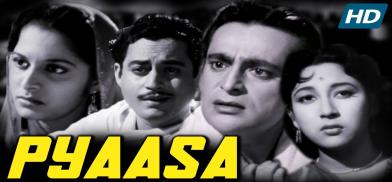Guru Dutt (1925 - 1964) : Unsung Auteur, Resurrected Genius
The most celebrated films in the Dutt oeuvre - Pyaasa (1957) and Kaagaz Ke Phool (1959), explored themes of unfulfilled love, societal alienation and the struggles of the human spirit, making him the unsung poet of Indian cinema. TIME magazine included Pyaasa in its ‘100 Best Films of All Time’

Legendary filmmaker Guru Dutt whose birth centenary (July 9 ) is being recalled with nostalgia and deep affection by film afficionados, died in a tragic manner on October 10, 1964. Was it suicide or an accidental overdoes of sleeping pills ?
This gifted auteur would have turned 40 a year later but his life was cut short - perhaps by his own despair and despondency and the many vicissitudes that punctuated his personal life and professional trajectory.
An auteur filmmaker
The most celebrated films in the Dutt oeuvre - Pyaasa (1957) and Kaagaz Ke Phool (1959), explored themes of unfulfilled love, societal alienation and the struggles of the human spirit, earning him recognition as the unsung poet of Indian cinema. TIME magazine included Pyaasa in its ‘100 Best Films of All Time’
The concept of the auteur filmmaker has its genesis in post-World War II French film criticism of the late 1940s with figures like François Truffaut and Jean-Luc Godard being key proponents. An auteur is a filmmaker, usually a director, whose personal vision and artistic style are strongly reflected in their work, marking them as the 'author' of the film. Furthermore, auteur directors exert significant personal control over all aspects of production and their films often exhibit recurring themes, stylistic choices, music, lyrics and a recognizable celluloid signature.
While there were other director-producer-actor filmmakers in then Bombay (now Mumbai) at that time, such as Raj Kapoor and Dev Anand - Guru Dutt is distinctive as an auteur. While he directed only eight films – they are all differently memorable. Alas, his aesthetic imprint on Indian cinema remained relatively under-acknowledged during his life and the films now recognized as masterpieces and cult classics were resurrected two decades after his demise.
The most celebrated films in the Dutt oeuvre - Pyaasa (1957) and Kaagaz Ke Phool (1959), explored themes of societal alienation and unfulfilled love respectively. Dutt’s USP in these two gems was his sensitive exploration of the angst of the committed artist and the struggles of the human spirit, making him the unsung poet of Indian cinema.
TIME magazine included Pyaasa in its ‘100 Best Films of All Time’ and this is a film that remains a beautifully envisioned, exquisitely filmed (due credit to Dutt’s cameraman VK Murthy) and deeply poignant celluloid story of abject materialism and true love that cannot be pursued. Dutt plays the lead role as the disillusioned poet Vijay and debutant Waheeda Rahman is the female protagonist, as the prostitute Gulabo who believes in and loves the poet, even when society has cast him aside as a failure.
The poet becomes increasingly bitter and cynical about capitalism and the depredations of market forces, rejecting the world and at the end of the film, cries out in anguish – ‘yeh duniya agar mil bhi jaaye toh kya hai’ (what does it mean , even if you win this universe? )
Haunting songs
The songs in both films are haunting and the biographical overtones with Dutt’s own troubled life are more than evident in ‘Kaagaz ke Phool’ where Dutt plays Suresh Sinha – the highly successful filmmaker who mourns:
Waqt ne kiya kya haseen sitam /Tum rahe na tum, hum rahe na hum / Beqarar dil is tarah mile / Jis tarah kabhi hum juda na the /Tum bhi kho gaye, hum bhi kho gaye / Ek raah par chalke do kadam
(Time has wrought such beautiful tragedy / You're no longer you and I'm no longer me/Our restless hearts met in such a way that / We've never ever been apart / You were lost and so was I / As we walked a few footsteps on the same path )
Use of light and shade
Guru Dutt’s filmography is varied and it would be misleading to see him as a dark and brooding filmmaker – though his best films do exude that texture. Dutt’s first film as a director (Baazi, 1951) a stylish crime drama with mass appeal was made with his lifelong friend Dev Anand under the Navketan banner. The next four years saw Dutt at his box-office peak and Aar Paar (1954) with the impish song ‘sun sun zaalima’ and ‘Mr. & Mrs. 55’ (1955) a romantic comedy with social undertones were acclaimed by the audiences. Evocative music and import-laden lyrics burnished the films and nuanced wit and humor (who can forget Johnny Walker as the ‘champiwala’ and the song ‘sar jo tera chakraya’ ) were hallmarks of the Guru Dutt films of that period.
For sheer feminine beauty, grace and delicate sensuousness captured on celluloid – there is nothing (IMO) that can match Dutt’s picturization of Waheeda Rehman in ‘Chaudhvi ka Chand’ and the title song is mesmerizing. This is a clip from the film that must be viewed in its entirety in an unhurried manner (https://www.youtube.com/watch?v=5Ud2rsMT5ng) and I am grateful to the multi-talented Mayank Chhaya for rendering a few lines of this song for SAM.
Among the great filmmakers of the last century, the Russian maestro Andrei Tarkovsky (1932- 86) was an auteur and his concept of 'sculpting in time' referred to his distinctive style of filmmaking. The temporal becomes a malleable element, akin to clay for the sculptor - and critics aver that Tarkovsky created a cinematic experience which “immersed viewers in the flow of time, using long takes, unedited footage, and a focus on the subtle relationships between moments.”
Guru Dutt used light and shade in a distinctive manner in all his films, with bewitching close-up shots and this point merits repetition – much of the magic was due to his accomplished camera artist Murthy. "Sculpting with light" in Mani Kaul’s words, to illuminate the darkness of life with a chiseled yet delicate touch, was an amazing feat of cinematic conception and technical execution – given the rudimentary nature of the cameras, lenses and related equipment that were available at the time.
Belated recognition
While a deep and brooding darkness engulfed Guru Dutt in the last few years of his life, a glowing light is now being focused on his amazing body of work – from ‘Baazi’ (1951) to ‘Baharen phir bhi ayengi’ which was incomplete when the filmmaker died and was completed by his team and released in 1966.
Posterity has been kinder to Guru Dutt and the resurrection of this genius in his birth centenary will hopefully accord him the recognition as a giften aeteur that eluded him in his life.
(The writer, an armed forces veteran, is a strategic analyst and an occasional commentator on the arts and cinema. Views are personal.)









Post a Comment